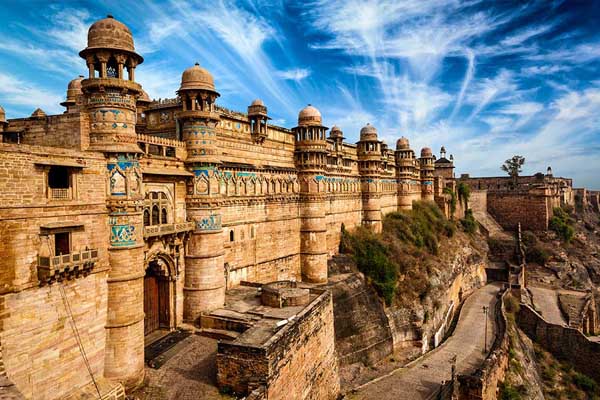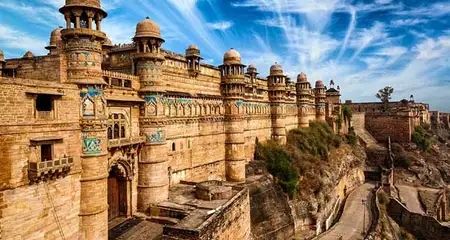One of the oldest forts in Madhya Pradesh as well as in India, Gwalior Fort is known for its stunning architecture and unique history. Sprawling and offering unforgettable city views, this hill fort has been ruled by dynasties of different kingdoms over the years. It is also considered as one of the most impenetrable forts in the country. Hence, if you are passionate about different cultures and their past glories, a visit to Gwalior Fort is a must.
Gwalior Fort Important Info:
|
Location |
Gwalior, Madhya Pradesh |
|
Timings |
7:00 AM to 5:30 PM |
|
Entry Fee |
For Indians: INR 75 per person For Foreigners: INR 250 per person |
|
Commissioned By |
Raja Suraj Sen Pal (according to a local legend) |
|
Area |
3 sq. km |
|
Year of Establishment |
3-4th Century |
|
Best Time to Visit |
August to March |
|
Time Required |
2-3 Hours |
|
Material Used |
Sandstone, lime mortar |
|
Entrance |
Hathi Pol, Urvai Gate |
Gwalior Fort: History
If you go by local legends, this majestic fort was constructed in 3rd CE, and was the brainchild of the then ruling emperor Raja Suraj Sen Pal. According to the same legend, the name of the fort was coined in honour of the sage ‘Gwalipa’ who helped cure the king’s leprosy affliction.
The interesting story of Gwalior Fort does not end here. Did you know that this is one of the most historic forts in Northern and Central India? It was not only ruled by the family of Suraj Sen, who was probably a Kachchhapaghata, but changed hands many times throughout history. Some historical accounts confirm that during the 16th century, the family lost possession of this fort and it was acquired by the Mughals and later by Marathas for a certain period.
Further, during the British regime, it was established as the Gwalior Kingdom which was earlier a province of the large Maratha empire. After independence, the Central Government took possession of this fort and has been taking care of it ever since.
The popularity of this fort had reached such heights around 1022 CE, that it was attacked for four consecutive days by Mahmud of Ghazni. Several other Mughal rulers fought wars to establish their hold over this mighty beauty!
Gwalior Fort: Today
Presently, the fort is open to anyone who wishes to be transported back in time to bask in the grandeur of medieval artefacts and impressive architectural designs. Due to its rich and intriguing history, there is a popular light and sound show organised here every evening. It is conducted at Man Mandir and offers tourists a fabulous opportunity to delve into some of the biggest events in history.
Gwalior Fort: Architecture
This grand Gwalior Fort sprawls over an area of nearly 3 sq. km. Its height is more than 10 m. The iconic fort built on a hilltop offers a spectacular 360-degree view of the landscape around it. You will also catch glimpses of massive water tanks that were specifically designed to store water for weeks and months.
The magnificent structure is mainly constructed with sandstones. However, the numerous temples and palaces built inside exhibit other materials as well. One of the most famous architectural gems you wouldn’t want to miss is the Teli ka Mandir, which is completely built in the ancient Dravidian style and is beautifully sculpted.
Things to see at Gwalior Fort
Make sure you explore each of these spots on your trip to Gwalior Fort.
- Urvahi Area: Here, you will find many idols and Jain statues, some of them more than 50 feet tall. The area showcases amazing sculptures that are nearly a thousand years old.
- Jain Temple Caves: Most famous of all Jain temple caves, the Siddhachal caves here are more than 500-700 years old. They are dedicated to tirthankaras and their idols. The most visited idol is that of Adinatha who was the first tirthankara.
- Gopachal: History buffs will surely fall in love with Gopachal, which boasts exquisite carvings on rocks, a testimony to the amazing artistic skills of the craftsmen in those days. This part of the fort was designed mostly during the Tomar dynasty. The major attraction here is the sculpture of Bhagwan Parsvanath.
- Teli ka Mandir: It is a Hindu temple that was constructed during the reign of Mihira Bhoja. As you walk around this impressive structure, you will find yourself awestruck by the concoction of North and South Indian architectural styles.
- Man Mandir Mahal: This mahal has a large amphitheatre, where the light and sound show is hosted every evening. It was built around the 15th century during Tomar dynasty.
- Bhim Singh Rana’s Chhatri: This chhatri, or memorial of Bhim Singh Rana, is more recent than most of the other structures. It was built in the 18th
- Gujari Mahal: This mahal is now a museum which was earlier built during the reign of Man Singh Tomar for Mrignayani, his wife. Many artefacts, scriptures and idols can be found here.
Suggested read: Things to do in Gwalior
How to reach Gwalior Fort
To reach Gwalior Fort, it is better if you hire a rickshaw or rent a private cab, which can take you up to the entrance of the fort. Depending on the entrance you visit, you may or may not be allowed inside the fort with the vehicle. Usually, Urvahi Gate, which opens to the western side of the fort, allows vehicles. If you wish to soak in the beauty of the surroundings, you can hike your way to the top of the grand fort. Located in the northern part of Madhya Pradesh, Gwalior is well connected via all transportation modes – road, air and train.
Lesser-known facts about Gwalior Fort
Here are a few things that not many people know about Gwalior Fort.
- One of the most interesting facts about Gwalior Fort is that it accounts for the second oldest record of ‘Zero’. It is found as an inscription in one of the oldest temples inside the fort. According to some historical records, the inscription is more than 1,000 years old.
- There is a unique temple here, known as Saas Bahu temple. According to a legend, due to an argument between the mother-in-law and the daughter-in-law of the royal kingdom, about worshipping two different deities, the statues of both Lord Vishnu and Lord Shiva were placed here.
- While this fort was once in the possession of Akbar, he used it as a prison and place for the execution of criminals.
Nearby attractions
- Tansen Memorial (1 km)
- Bir Singh Palace (76 km)
- Madhav National Park (122 km)
- Orchha (123 km)
- Bateshwar (123 km)
- Khajuraho (279 km)
- Panna National Park (360 km)
- Sanchi (394 km)
Also read: best places to visit in Gwalior
Whether you are someone who loves historical forts and monuments or an admirer of unique architectures, a visit to Gwalior Fort can blow your mind. It will help you travel back in time and witness the royal and opulent past of India. The state of Madhya Pradesh is also peppered with many other attractions, from national parks and temples to palaces and forts, which you can include in your itinerary. All you need to do is book your flight or train and accommodation in advance, so that you get your money’s worth.




























